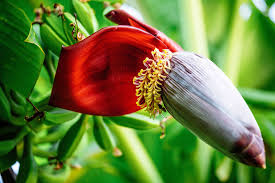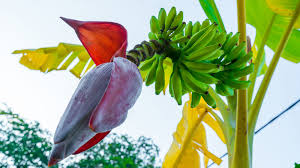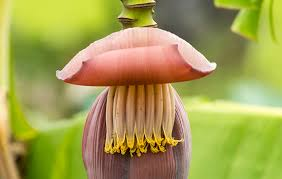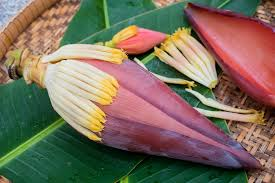Banana flowers, also known as banana blossoms, are an intriguing and multifaceted part of the banana plant. Found at the end of the banana fruit cluster, these large, teardrop-shaped flowers are rich in nutritional value and have diverse culinary, medicinal, and cultural applications.
Structurally, a banana flower is made up of tightly packed, overlapping bracts, which are reddish-purple in color and somewhat leathery in texture. Inside these bracts are rows of cream-colored, tubular flowers. The flowers are of two types: the larger, outer female flowers, which develop into bananas, and the smaller, inner male flowers, which typically do not develop into fruit and are often harvested for use.
Culinary uses of banana flowers are prevalent in various Asian and tropical cuisines. The inner petals and florets are edible and are used in salads, soups, curries, and stir-fries. They have a unique, slightly bitter flavor and a crunchy texture. In Southeast Asian cooking, banana flowers are commonly used as a vegetable.
For example, in Thai cuisine, they are added to curries and salads, while in Filipino cuisine, they are known as “puso ng saging” and are cooked in stews and sautéed dishes. The flowers are also used in Indian cuisine, often in dishes like banana flower vada (fritters) and thoran (stir-fried with coconut).
Nutritionally, banana flowers are a powerhouse. They are rich in dietary fiber, vitamins A, C, and E, and essential minerals such as potassium, magnesium, and calcium. Their high fiber content aids in digestion and helps in maintaining a healthy gut. The flowers also have antioxidant properties, which can help in reducing inflammation and fighting off free radicals in the body.
Medicinally, banana flowers have been used in traditional remedies for their numerous health benefits. They are known for their ability to regulate blood sugar levels, making them beneficial for people with diabetes. The flowers are also believed to have antibacterial properties, which can aid in treating infections. Additionally, they are used to manage menstrual disorders and promote lactation in breastfeeding mothers. The extracts from banana flowers are sometimes used in herbal supplements and natural remedies.
Culturally, banana flowers hold significance in various traditions and rituals. In some Southeast Asian cultures, they are used in ceremonial offerings and traditional medicines. The blossoms are often featured in religious rituals and celebrations, symbolizing fertility and prosperity. Their unique appearance and vibrant color make them a popular choice for decorative purposes in festivals and events.
In agriculture, banana flowers play a crucial role in the development of banana fruit. The outer bracts gradually peel away, allowing the female flowers to be pollinated and develop into clusters of bananas. The male flowers, which are often removed during cultivation, can be used as an additional resource, adding value to the banana plant beyond fruit production.
Environmentally, the use of banana flowers promotes sustainability. By utilizing all parts of the banana plant, from the fruit to the leaves and flowers, farmers can reduce waste and make the most of their crops. This holistic approach to agriculture supports the efficient use of natural resources and minimizes environmental impact.
Banana flowers are a versatile and valuable part of the banana plant, with a wide range of applications in culinary, medicinal, cultural, and agricultural contexts. Their nutritional benefits and unique flavor make them a sought-after ingredient in various cuisines, while their medicinal properties offer potential health benefits. Culturally significant and environmentally sustainable, banana flowers exemplify the richness and diversity of natural resources.
The Economic Importance and Uses of Banana Flowers

1. Culinary Uses: Banana flowers are used in various cuisines around the world. They are cooked in dishes like salads, curries, and stir-fries. For example, in Indian cuisine, banana flower curry is a popular dish.
2. Nutritional Value: Banana flowers are rich in vitamins and minerals, making them a healthy addition to diets. They are especially high in fiber, protein, and antioxidants.
3. Traditional Medicine: Banana flowers are used in traditional medicine to treat ailments such as menstrual problems, diabetes, and infections.
4. Animal Feed: Banana flowers can be used as feed for livestock, providing a nutritious supplement.
5. Antioxidant Properties: The flowers contain compounds with antioxidant properties, which are beneficial for health and can be used in nutraceuticals.
6. Anti-inflammatory Properties: Banana flowers have anti-inflammatory effects and are used in herbal treatments to reduce inflammation.
7. Bioactive Compounds: The flowers are a source of bioactive compounds that have potential pharmaceutical applications.
8. Dietary Supplements: Extracts from banana flowers are used in dietary supplements due to their high nutrient content.
9. Weight Management: Due to their high fiber content, banana flowers can help in weight management by promoting a feeling of fullness.
10. Blood Sugar Control: The flowers have been shown to help regulate blood sugar levels, making them beneficial for people with diabetes.
11. Skin Care: Banana flowers are used in natural skin care products due to their antioxidant and anti-inflammatory properties.
12. Floral Arrangements: The attractive appearance of banana flowers makes them popular in floral arrangements and decorations.
13. Soil Fertility: Decomposed banana flowers can be used as organic fertilizer to improve soil fertility.
14. Composting: Banana flowers are excellent for composting, providing rich organic material for gardens.
15. Biochar Production: The flowers can be converted into biochar, which improves soil fertility and sequesters carbon.
16. Natural Dye: Extracts from banana flowers can be used to produce natural dyes for textiles and other materials.
17. Beekeeping: The nectar from banana flowers attracts bees, supporting beekeeping and pollination activities.
18. Culinary Pickles: Banana flowers can be pickled and preserved, adding to the variety of preserved foods.
Read Also: Honey Production Guide: The Basics to Get Started
The Products and By-products That Can Be Derived From Banana Flowers

1. Culinary Dishes: Banana flowers are used in a variety of dishes such as curries, salads, and soups. The process involves cleaning, chopping, and cooking the flowers.
2. Nutritional Supplements: Extracts from banana flowers are used in supplements due to their high nutrient content. The process includes drying and powdering the flowers.
3. Traditional Medicine: Banana flowers are used in herbal remedies for various health conditions. The process involves preparing the flowers as extracts or infusions.
4. Animal Feed: Chopped banana flowers are used as nutritious feed for livestock. The process includes harvesting and processing the flowers.
5. Antioxidant Extracts: The flowers are processed to extract antioxidant compounds for use in nutraceuticals. This involves solvent extraction and purification.
6. Anti-inflammatory Products: Extracts from banana flowers are used in products to reduce inflammation. The process includes extracting active compounds and formulating them into products.
7. Bioactive Compounds: Banana flowers are processed to isolate bioactive compounds for pharmaceutical applications. This involves extraction and analysis of compounds.
8. Dietary Supplements: Banana flower extracts are used in dietary supplements. The process includes drying, grinding, and encapsulating the extracts.
9. Weight Management Products: High-fiber extracts from banana flowers are used in weight management products. This involves processing the flowers into powders or extracts.
10. Blood Sugar Control Supplements: Extracts that help regulate blood sugar levels are used in supplements. This involves processing the flowers into standardized extracts.
11. Skin Care Products: Banana flower extracts are used in natural skin care products. The process includes extracting active compounds and formulating them into creams and lotions.
12. Floral Arrangements: Fresh banana flowers are used in floral arrangements. The process includes harvesting and arranging the flowers.
13. Organic Fertilizer: Decomposed banana flowers are used as organic fertilizer. This involves composting the flowers and applying the compost to crops.
14. Compost: Banana flowers are composted to produce rich organic material for gardening. The process includes chopping and mixing the flowers with other organic waste.
15. Biochar: Banana flowers are converted into biochar through pyrolysis. This involves heating the flowers in a low-oxygen environment.
16. Natural Dye: Extracts from banana flowers are used to produce natural dyes. The process includes boiling the flowers and extracting the dye.
17. Beekeeping: Fresh banana flowers are used in beekeeping to attract bees. The process includes cultivating banana plants and harvesting the flowers.
Read Also: Facts About Honey Bees
Frequently Asked Questions (FAQ’s) About Banana Flowers

1. What are banana flowers used for?
Banana flowers are used for culinary dishes, nutritional supplements, traditional medicine, animal feed, antioxidants, anti-inflammatory products, bioactive compounds, dietary supplements, weight management, blood sugar control, skin care products, floral arrangements, organic fertilizer, compost, biochar, natural dye, and beekeeping.
2. How do you prepare banana flowers for cooking?
To prepare banana flowers for cooking, peel the outer layers, chop the tender inner parts, and cook them in dishes like curries, salads, and soups.
3. Are banana flowers edible?
Yes, banana flowers are edible and used in various culinary dishes, especially in Asian cuisine.
4. What are the health benefits of banana flowers?
Banana flowers are rich in vitamins, minerals, fiber, protein, and antioxidants. They are used to treat ailments such as menstrual problems, diabetes, and infections, and they help in weight management and blood sugar control.
5. Can banana flowers be used in traditional medicine?
Yes, banana flowers are used in traditional medicine to treat digestive issues, infections, and other ailments.
6. How are banana flowers used in dietary supplements?
Extracts from banana flowers are used in dietary supplements due to their high nutrient content. They are dried, powdered, and encapsulated.
7. What are the antioxidant properties of banana flowers?
Banana flowers contain compounds with antioxidant properties that help protect the body from oxidative stress and improve overall health.
8. Can banana flowers be used in skin care products?
Yes, banana flower extracts are used in natural skin care products due to their antioxidant and anti-inflammatory properties.
9. How are banana flowers used in beekeeping?
The nectar from banana flowers attracts bees, supporting beekeeping and pollination activities.
10. Are there commercial products made from banana flowers?
Yes, products such as culinary dishes, nutritional supplements, traditional medicine remedies, animal feed, antioxidant extracts, anti-inflammatory products, bioactive compounds, dietary supplements, weight management products, blood sugar control supplements, skin care products, floral arrangements, organic fertilizer, compost, biochar, natural dyes, and beekeeping supplies are made from banana flowers.
Read Also: Financial Projections for Waste Management Business

